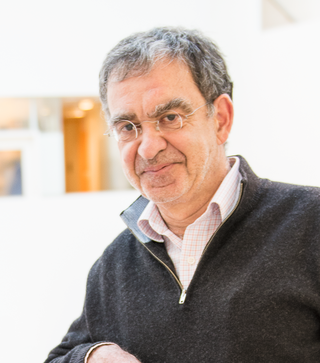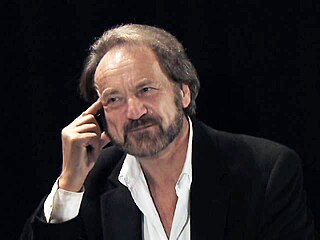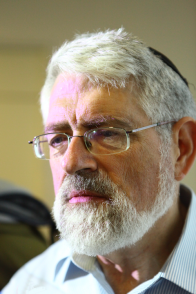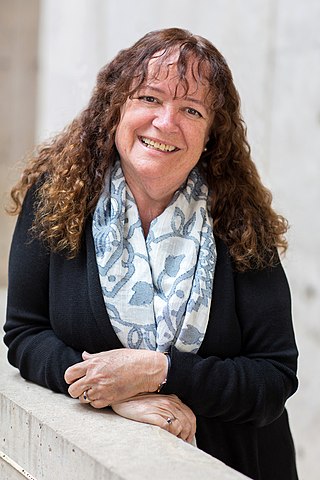Related Research Articles

Cognitive neuroscience is the scientific field that is concerned with the study of the biological processes and aspects that underlie cognition, with a specific focus on the neural connections in the brain which are involved in mental processes. It addresses the questions of how cognitive activities are affected or controlled by neural circuits in the brain. Cognitive neuroscience is a branch of both neuroscience and psychology, overlapping with disciplines such as behavioral neuroscience, cognitive psychology, physiological psychology and affective neuroscience. Cognitive neuroscience relies upon theories in cognitive science coupled with evidence from neurobiology, and computational modeling.

The Salk Institute for Biological Studies is a scientific research institute located in the La Jolla community of San Diego, California. The independent, non-profit institute was founded in 1960 by Jonas Salk, the developer of the polio vaccine; among the founding consultants were Jacob Bronowski and Francis Crick. Construction of the research facilities began in spring of 1962. The Salk Institute consistently ranks among the top institutions in the US in terms of research output and quality in the life sciences. In 2004, the Times Higher Education Supplement ranked Salk as the world's top biomedicine research institute, and in 2009 it was ranked number one globally by ScienceWatch in the neuroscience and behavior areas.
Computational neuroscience is a branch of neuroscience which employs mathematics, computer science, theoretical analysis and abstractions of the brain to understand the principles that govern the development, structure, physiology and cognitive abilities of the nervous system.

Patricia Smith Churchland is a Canadian-American analytic philosopher noted for her contributions to neurophilosophy and the philosophy of mind. She is UC President's Professor of Philosophy Emerita at the University of California, San Diego (UCSD), where she has taught since 1984. She has also held an adjunct professorship at the Salk Institute for Biological Studies since 1989. She is a member of the Board of Trustees Moscow Center for Consciousness Studies of Philosophy Department, Moscow State University. In 2015, she was elected a Fellow of the American Academy of Arts & Sciences. Educated at the University of British Columbia, the University of Pittsburgh, and Somerville College, Oxford, she taught philosophy at the University of Manitoba from 1969 to 1984 and is married to the philosopher Paul Churchland. Larissa MacFarquhar, writing for The New Yorker, observed of the philosophical couple that: "Their work is so similar that they are sometimes discussed, in journals and books, as one person."

Peter Dayan is a British neuroscientist and computer scientist who is director at the Max Planck Institute for Biological Cybernetics in Tübingen, Germany, along with Ivan De Araujo. He is co-author of Theoretical Neuroscience, an influential textbook on computational neuroscience. He is known for applying Bayesian methods from machine learning and artificial intelligence to understand neural function and is particularly recognized for relating neurotransmitter levels to prediction errors and Bayesian uncertainties. He has pioneered the field of reinforcement learning (RL) where he helped develop the Q-learning algorithm, and made contributions to unsupervised learning, including the wake-sleep algorithm for neural networks and the Helmholtz machine.
Brian R. Christie is a Professor of Medicine and Neuroscience at The University of Victoria. He helped found the Neuroscience Graduate Program at the University of Victoria and served as its director from 2010–2017. He is a Michael Smith Senior Scholar Award winner. Christie received his PhD in 1992 from the University of Otago before doing postdoctoral work with Daniel Johnston at Baylor College of Medicine and Terrence Sejnowski at the Salk Institute for Biological Studies, and then became Assistant Professor at the University of British Columbia. Promoted to Associate Professor in 2007. Full Professor in 2013.
Pendleton Read Montague, Jr. is an American neuroscientist and popular science author. He is the director of the Human Neuroimaging Lab and Computational Psychiatry Unit at the Fralin Biomedical Research Institute at VTC in Roanoke, Virginia, where he also holds the title of the inaugural Virginia Tech Carilion Vernon Mountcastle Research Professor. Montague is also a professor in the department of physics at Virginia Tech in Blacksburg, Virginia and professor of Psychiatry and Behavioral Medicine at Virginia Tech Carilion School of Medicine.

Tomaso Armando Poggio, is the Eugene McDermott professor in the Department of Brain and Cognitive Sciences, an investigator at the McGovern Institute for Brain Research, a member of the MIT Computer Science and Artificial Intelligence Laboratory (CSAIL) and director of both the Center for Biological and Computational Learning at MIT and the Center for Brains, Minds, and Machines, a multi-institutional collaboration headquartered at the McGovern Institute since 2013.

Roger Bingham was a British science educator, author and television host based in La Jolla, California. He was co-founder and director of the Science Network (TSN), a virtual forum dedicated to science and its impact on society. Bingham was also the creator of the Beyond Belief conferences.

Earl Keith Miller is a cognitive neuroscientist whose research focuses on neural mechanisms of cognitive, or executive, control. Earl K. Miller is the Picower Professor of Neuroscience with the Picower Institute for Learning and Memory and the Department of Brain and Cognitive Sciences at Massachusetts Institute of Technology. He is the Chief Scientist and co-founder of SplitSage. He is a co-founder of Neuroblox.
Ralph Mitchell Siegel, a researcher who studied the neurological underpinnings of vision, was a professor of neuroscience at Rutgers University, Newark, in the Center for Molecular and Behavioral Neuroscience. He died September 2, 2011, at his home following a long illness.

Daniel Mark Wolpert FRS FMedSci is a British medical doctor, neuroscientist and engineer, who has made important contributions in computational biology. He was Professor of Engineering at the University of Cambridge from 2005, and also became the Royal Society Noreen Murray Research Professorship in Neurobiology from 2013. He is now Professor of Neurobiology at Columbia University.
Laurence Frederick Abbott is an American theoretical neuroscientist, who is currently the William Bloor Professor of Theoretical Neuroscience at Columbia University, where he helped create the Center for Theoretical Neuroscience. He is widely regarded as one of the leaders of theoretical neuroscience, and is coauthor, along with Peter Dayan, on the first comprehensive textbook on theoretical neuroscience, which is considered to be the standard text for students and researchers entering theoretical neuroscience. He helped invent the dynamic clamp method alongside Eve Marder.

Haim Sompolinsky, is the William N. Skirball Professor of Neuroscience at the Edmond and Lily Safra Center for Brain Sciences, and a professor of physics at the Racah Institute of Physics at The Hebrew University of Jerusalem, Israel. He is also a visiting professor in the Center of Brain Science at Harvard University and the director of Harvard's Swartz Program in Theoretical Neuroscience. He is widely regarded as one of the leaders of theoretical neuroscience.
Alexandre Pouget is a full Professor at the University of Geneva in the department of basic neurosciences.

Tatyana Sharpee is an American neuroscientist. She is a Professor at the Salk Institute for Biological Studies, where she spearheads a research group at the Computational Neurobiology Laboratory, with the support from Edwin Hunter Chair in Neurobiology. She is also an Adjunct Professor at the Department of Physics at University of California, San Diego. She was elected a fellow of American Physical Society in 2019.

Margarita Behrens is a neuroscientist and biochemist. She is currently an associate professor at the Salk Institute for Biological Studies where her lab studies the impact of oxidative stress on the post-natal brain through probing the biology of fast-spiking parvalbumin interneurons in models of schizophrenia.

Kanaka Rajan is a computational neuroscientist in the Department of Neurobiology at Harvard Medical School and founding faculty in the Kempner Institute for the Study of Natural and Artificial Intelligence at Harvard University. Rajan trained in engineering, biophysics, and neuroscience, and has pioneered novel methods and models to understand how the brain processes sensory information. Her research seeks to understand how important cognitive functions — such as learning, remembering, and deciding — emerge from the cooperative activity of multi-scale neural processes, and how those processes are affected by various neuropsychiatric disease states. The resulting integrative theories about the brain bridge neurobiology and artificial intelligence.
François Guillemot,, is a French neurobiologist, currently working at the Francis Crick Institute in London. His research focuses on the behaviour of neural stem cells in embryos and adult brains.
John Reynolds is an American neuroscientist. He is a professor at the Salk Institute for Biological Studies, adjunct professor at University of California, San Diego, and member of the advisory board for the Kavli Foundation Kavli Institute for the Brain and Mind. He studies perception and vision and is known for developing a computational model of attention that scientists use as a framework for understanding how the brain performs attentional selection.
References
- ↑ "Terrence Sejnowski". Salk.edu. Retrieved 28 April 2019.
- ↑ "CNL : The Computational Neurobiology Laboratory". Cnl.salk.edu. Retrieved 28 April 2019.
- ↑ "Terrence J. Sejnowski". Biology.ucsd.edu. Retrieved 28 April 2019.
- ↑ "Behavior and Our Brain - Mysteries of the Brain - Terry Sejnowski - Brain, Behavior, Neuroscience, Sejnowski - sciencestage.com Medicine". sciencestage.com. Archived from the original on 12 June 2010. Retrieved 17 January 2022.
- 1 2 Markoff, John (29 December 2015). "The Most Popular Online Course Teaches You to Learn". The New York Times. Retrieved 3 January 2016.
The world's most popular online course is a general introduction to the art of learning, taught jointly by an educator and a neuroscientist.
- ↑ "Learning How to Learn: Powerful mental tools to help you master tough subjects".
- ↑ James A. Anderson, Edward Rosenfeld eds. (2000) Talking Nets: An Oral History of Neural Networks. Chapter 14. MIT Press
- ↑ Brenner, Sydney; Sejnowski, Terrence (10 September 2018). In The Spirit Of Science: Lectures By Sydney Brenner On Dna, Worms And Brains. World Scientific. p. 47. ISBN 978-981-327-175-3.
- ↑ "IEEE Fellows 2000". IEEE Communications Society.
- ↑ Design Futures Council Senior Fellows "Senior Fellows :: DesignIntelligence". Archived from the original on 6 November 2007. Retrieved 6 November 2007.
- ↑ Institute of Medicine "NIMH · Institute of Medicine of the National Academies Announces New Members". Archived from the original on 2 April 2015. Retrieved 7 March 2015.
- ↑ "Terrence Sejnowski". Nasonline.org. Retrieved 28 April 2019.
- ↑ "72 New Members Chosen By Academy". 8.nationalacademies.org. Retrieved 28 April 2019.
- ↑ "NAE Elects 68 Members and Nine Foreign Members". Nae.edu. Retrieved 28 April 2019.
- ↑ "National Academy of Inventors". Academyofinventors.org. Retrieved 28 April 2019.
- ↑ "Terrence Sejnowski, May 7, 2018". Engineering-Driven Medicine Distinguished Lecture. Stony Brook University College of Engineering and Applied Sciences. Retrieved 13 June 2022.
- ↑ "2013 Fellows and their affiliations at the time of election" (PDF). American Academy of Arts and Sciences. Archived from the original (PDF) on 12 May 2013. Retrieved 17 January 2022.
- ↑ "APS Fellowship". Aps.org. Retrieved 28 April 2019.
- ↑ "Awards". Sfn.org. Retrieved 28 April 2019.
- ↑ Gruber Neuroscience Prize 2022
- ↑ Meyer, M. (2024, March 5). Pioneering work in computational and theoretical neuroscience is awarded the world’s largest brain research prize. The Lundbeck Foundation.
- ↑ "Princeton awards seven honorary degrees". Princeton University. 28 May 2024. Retrieved 4 June 2024.
- ↑ Ackley, D. H. Hinton, G. E. Sejnowski, T. J. A Learning Algorithm for Boltzmann Machines*, Cognitive Science, 9, 147–169, 1985
- ↑ Sejnowski, T. J. Rosenberg, C. R. Parallel Networks That Learn to Pronounce English Text, Complex Systems, 1, 145–168, 198
- ↑ Lehky, S. R. Sejnowski, T. J. Network Model of Shape-from-Shading: Neural Function Arises from Both Receptive and Projective Fields, Nature, 333, 452–454, 1988
- ↑ Bell, A. J. Sejnowski, T. J. An Information-Maximization Approach to Blind Separation and Blind Deconvolution, Neural Computation, 7, 1129–1159, 1995
- ↑ Coggan, J. S. Bartol, T. M. Jr. Esquenazi, E. I. Stiles, J. R. Lamont, S. Martone, M. E. Berg, D. K. Ellisman, M. H. Sejnowski, T. J. Evidence for Ectopic Neurotransmission at a Neuronal Synapse, Science, 39, 446–451, 2005
- ↑ Makeig, S., Westerfield, M., Jung, T.-P., Enghoff, S., Townsend, J., Courchesne, E., Sejnowski, T. J. Dynamic brain sources of visual evoked responses. Science, 295: 690–694(2002)
- ↑ Bingham, Roger; Terrence Sejnowski; Jerry Siegel; Mark Eric Dyken; Charles A. Czeisler; Paul Shaw; Ralph Greenspan; Satchin Panda; Philip Low; Robert Stickgold; Sara Mednick; Allan Pack; Luis de Lecea; David Dinges; Dan Kripke; Giulio Tononi (February 2007). "Waking Up To Sleep" (Several conference videos). The Science Network. Retrieved 25 January 2008.
- ↑ "Advisory Committee to the Director. Brain Research through Advancing Innovative Neurotechnologies (BRAIN) Working Group: Roster" (PDF). National Institutes of Health. Archived from the original (PDF) on 24 April 2013. Retrieved 14 April 2013.
- ↑ "BRAIN 2025 Report – Brain Initiative". Braininitiative.nih.gov. Retrieved 28 April 2019.
- ↑ Alivisatos, A. P., Chun, M., Church, G.M., Deisseroth, K., Donoghue, J.P., Greenspan, R.J., McEuen, P.L., Roukes, M.L., Sejnowski, T. J., Weiss, P.S., Yuste, R., The Brain Activity Map, Science, 339, 1284–1285 (2013).
- ↑ Churchland, P. S. and Sejnowski, T. J., The Computational Brain, Cambridge, MA: MIT Press (1992).
- ↑ HarperCollins (23 September 2003). Liars, Lovers, and Heroes. Harper Collins. ISBN 9780060001490 . Retrieved 27 August 2015.